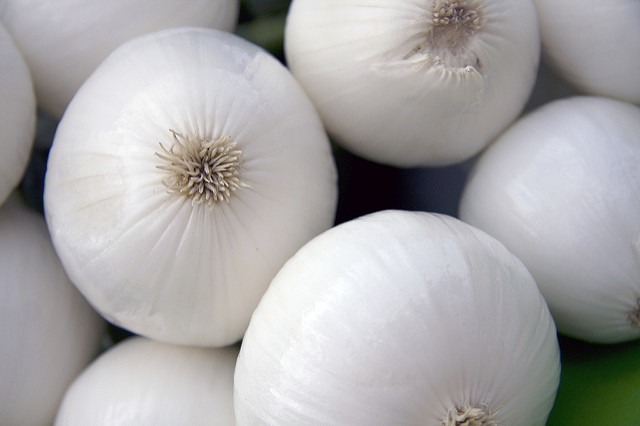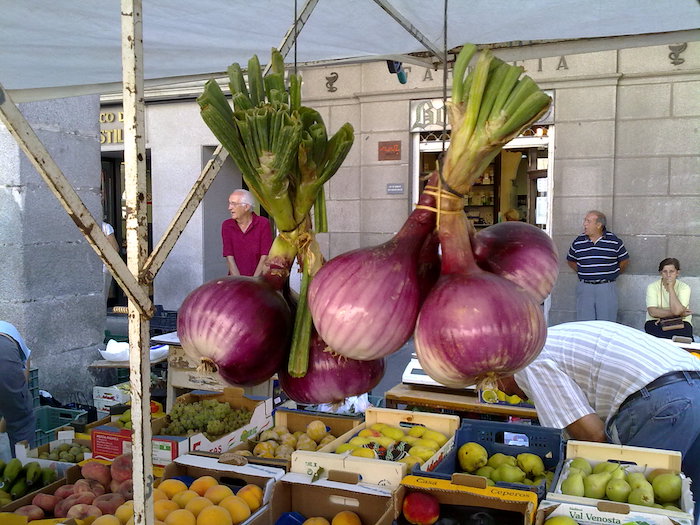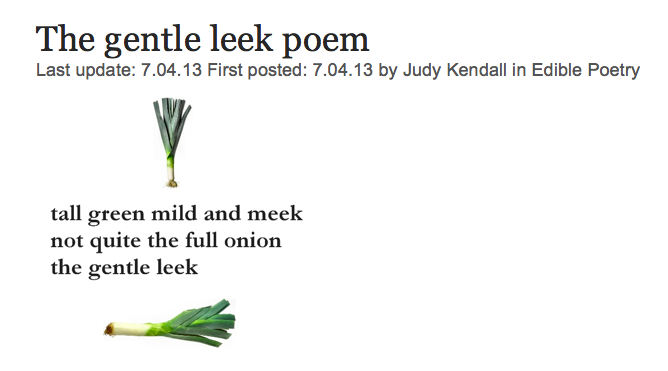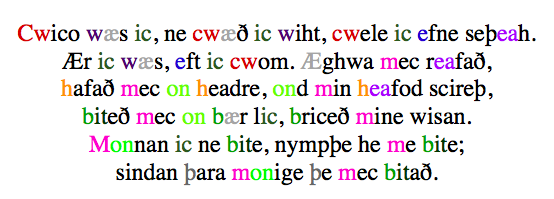Exeter Riddle 65
MEGANCAVELL
Date: Thu 10 Aug 2017Matching Commentaries: Commentary for Exeter Riddle 65
Riddle 65’s translation comes to us from Judy Kendall, Reader in English and Creative Writing at Salford University. She’s especially interested in poetic composition, visual text and translation, both in an academic context and from the standpoint of a creative practitioner. You can see her creative record of the process of translating an Old English riddle in ‘brief brief: a riddle’ in Amsterdam’s Versal Literary & Arts Journal, issue 12.
Cwico wæs ic, ne cwæð ic wiht, cwele ic efne seþeah.
Ær ic wæs, eft ic cwom. Æghwa mec reafað,
hafað mec on headre, ond min heafod scireþ,
biteð mec on bær lic, briceð mine wisan.
Monnan ic ne bite, nympþe he me bite;
sindan þara monige þe mec bitað.
Quick to life I was, I did not quip at all, yet even so I’m quelled.
Before I was, renewed I came. I’m everybody’s quarry,
they hold me in fetters, and hack off my head,
bite my stripped body, snap my stalk.
I will not bite a man, unless he bites me;
many are they that bite me.
Notes:
This riddle appears on folio 125r of The Exeter Book.
The above Old English text is based on this edition: Elliott van Kirk Dobbie and George Philip Krapp, eds, The Exeter Book, Anglo-Saxon Poetic Records 3 (New York: Columbia University Press, 1936), page 230.
Note that this edition numbers the text Riddle 63: Craig Williamson, ed., The Old English Riddles of the Exeter Book (Chapel Hill: University of North Carolina Press, 1977), page 105.
Tags: anglo saxon exeter book riddles old english solutions riddle 65
Related Posts:
Commentary for Exeter Riddle 65
Exeter Riddle 9
Exeter Riddle 72




Commentary for Exeter Riddle 64
VICTORIASYMONS
Date: Fri 04 Aug 2017Matching Riddle: Exeter Riddle 64
Do you like runes? Well I hope the answer’s yes, because there’s rather a lot of them going on here. Runes crop up relatively often in the Exeter Book, mostly clustered in and around the riddles. But Riddle 64 really goes to town on the old script mixing. Did you know this poem has a higher ratio of runes-to-lines than any other in the Exeter Book? True story.
Not that the runes make this poem particularly…poetic. Of all the runic riddles, this one has received the least scholarly attention in its own right. That’s because there’s just so little of it, apart from the runes. And they don’t seem to offer much help. For the record, wi (ᚹᛁ) is not a meaningful word, and nor are any of the other pairs of runes in this poem. Craig Williamson points out Riddle 64’s “absurd difficulty” (page 327), and he isn’t wrong.
Searching for the word "Wi" only brings up lots of images of Madison, WI.
Which is… not much help.
Image (by Dori) from Wikimedia Commons (Licence: Dual GFDL CC).
To make any sort of headway with Riddle 64, we need to cast our minds all the way back to the first of the Exeter Book’s runic riddles: Riddle 19. In fact, it’s worth having another read of that poem and commentary before going further. You’ll quickly see these two riddles have a lot in common, beyond their fondness for runic puzzles. They both describe a siþ (journey) over a wong (plain), embarked upon by a collection of runic-ly encoded creatures, some of which carry others.
These similarities can be pushed further still. The first runic creature in Riddle 19 is hors (horse). Another word for “horse” in Old English is wicg, which might conceivably be an expansion of that first pair of runes on line 1 (ᚹᛁ / wi). Next, Riddle 19 gives us mon (man) and wiga (warrior) (?), synonyms for which include beorn (ᛒᛖ / be on line 2) and þegn (ᚦᛖ / þe on line 4). Finally, Riddle 19’s haofoc seems to be replicated in Riddle 64 as hafoc (ᚻᚪ / ha, line 3), and paralleled by fælca (ᚠᚫ / fæ, line 5). I’ll come back to the final three runes, which are bit trickier, but you get the idea.
Like this, but more runey. Image from Metropolitan Museum of Art via Wikimedia Commons (licence: CC0 1.0 Universal Public Domain Dedication).
It still feels like a bit of a cheat, though. I don’t think modern readers would’ve gotten very far with this riddle if we didn’t have Riddle 19 to crib from, and I do wonder whether our early medieval counterparts would’ve fared much better. On that note, Riddle 64 isn’t the only runic puzzle on this page of the Exeter Book. The manuscript’s upper margin boasts its own runic message, written in dry point (ie scratched with a sharp tool) some time after the manuscript was completed. As far as anyone can make out, the letters seem to read:
ᛒ ᚢ ᚷ ᚱ ᚦ (bugrþ) or ᛒ ᚢ ᚾ ᚱ ᚦ (bunrþ)
What does this mean, you ask? No one knows! Williamson comments – half jokingly – that the latter sequence could be expanded into Beo unreþe (“Don’t be cruel!”, page 327): the complaint of a frustrated reader. My feeling is that this frustrated reader could have left an intentionally nonsensical enigma to match the apparently unreadable runes in the riddle. But the meaning of this little message is still very much up for grabs, if you’ve got a better idea!
Coming back to the poem. Riddle 64 is similar enough to Riddle 19 that scholars generally agree the two share a common solution. Those solutions tend to fall into one of three groups: something to do with hunting (Trautmann; Tupper); something to do with writing (Eliason; Shook); something to do with boats (Williamson; Griffith). Megan’s already done an ace job of setting out the arguments for and against each, and incidentally I’d be remiss if I didn’t take this opportunity to re-post some of Megan’s A-grade artwork:
I’ve chosen this picture not only for its fine artistic qualities, but because it’s an excuse to talk a little more about the “writing” solution first put forward by Eliason. Although most recent scholarship on these two riddles has favoured a solution relating to boats, I actually think “writing” deserves at least equal consideration. There’s some interesting overlaps between Riddle 64 (and 19, for that matter), and several of the Exeter Book’s writing riddles.
Journeying as a metaphor for writing was a popular trope in early medieval literature. In his influential Etymologiae, Isidore of Seville claims that: litterae autem dictae quasi legiterae, quod iter legentibus praestent (letters [littera] are so called as if the term were legitera, because they provide a road [iter] for those who are reading [legere]) (I.iii.3, in Barney, page 39).
Isidore of Seville: never one to let actual etymology get in the way of good imagery. Photo (by Luis García) from Wikimedia Commons (licence: Attribution-Share Alike 2.5 Generic).
We see this metaphor employed in Riddle 26 (lines 7-11), and it’s the central image of Riddle 51. It’s also used in Riddle 95, which Willamson solves as “book” (pages 397-402), and Murphy as “pen” (page 88). Riddle 51, in particular, emphasises the unity of the travelling companions (Murphy, page 86), in a way that’s quite reminiscent of Riddle 64.
These writing riddles also feature quite a lot of birds (Bitterli, pages 35-46; Murphy, page 85), and for a good reason. Pens at the time were often quills made from feathers of larger water birds, such as geese or swans.
Like so.
Image credit: Kijker Museum via Wikimedia Commons (Public Domain).
If you’ve ever found a seagull feather on the beach and swished it about a bit (don’t do this – seagulls are pretty gross), you’ll know they offer up quite a bit of air resistance. You can imagine a scribe experiencing something similar when writing with a quill. And this overlap between pens, feathers and flight gives rise to some of the most imaginative imagery of the writing riddles, such as when Riddle 26 describes its pen as the “bird’s joy” (fugles wyn, line 7b), or when the pen in Riddle 51 moves through the air “faster than birds” (fulgum framra, line 4a). Riddle 95 refers to the “delight of plunders” (hiþendra hyht, line 5a), which has been taken as a kenning for a quill pen (Murphy, page 95), and gives us a nice parallel to the description in Riddle 64 of the falcon as the “keeper’s joy” (habbendes hyht, line 3a).
To recap: in this interpretation, the “warrior” is the hand of the scribe (contributing its “share of the power”), while the “horse” that carries him on this journey is the point of the pen, and the “falcon” joyously flying above them is the pen’s plume swishing through the air as the scribe writes. They’re all travelling in unison across the “plain” of the manuscript page, and having a jolly good time about it.
Which just leaves that tricky last set of runes: ea–s–p. Although it’s difficult to be sure what the poet had in mind for this one, Williamson argues convincingly that it’s a contraction of the compound ea-spor, meaning “water-track” (page 326). There could be a parallel to this in Riddle 19 if the runic group on line 6 is taken to be wega “wave” rather than wiga “warrior.”
This word gives some support for the “boat” interpretation, but I don’t think it rules out “writing” either. Riddle 51 is quite taken with the image of the pen as a bird soaring through the air and then diving under the waves (ie into an ink pot), and both it and Riddle 26 describe pens leaving inky lastas “tracks” (see also Riddle 95, line 11b). So, to keep with our writing solution, the “water-track” is the line of ink left in the wake of the warrior scribe. And this is as good a place as any to bring in my favourite sea-related writing metaphor, which is from a colophon (or notation) added by one Æthelberht at the end of an eighth-century book of Psalms:
Finit liber psalmorum. In Christo Iesu domino nostro; lege in pace. Sicut portus oportunus nauigantibus ita uorsus [sic] nouissimus scribentibus.
(Here finishes the book of the Psalms. In Christ Jesus our Lord; read in peace. Just as the port is welcome to sailors, so is the final verse to scribes.) (Gameson, page 35; see also this excellent blogpost by Thijs Porck)
Image credit: Urban via Wikimedia Commons (licence: Dual GFDL CC).
So, that’s the case for solving this riddle as writing. I think there’s something quite appealing in the image of a pen in hand as a warrior and entourage, venturing forth across the page, leaving dark trails of watery ink in their wake. And this solution also helps to explain the inclusion of all those runes. What better place to show off your skill with not one but two alphabets, than in a poem that’s all about… writing!
References and Suggested Reading:
Barney, Stephen A., W. J. Lewis, J. A. Beach and Oliver Berghof, eds and trans. The Etymologies of Isidore of Seville. Cambridge: Cambridge University Press, 2006.
Bitterli, Dieter. Say What I Am Called: The Old English Riddles of the Exeter Book and the Anglo-Latin Tradition. Toronto: University of Toronto Press, 2009.
Dewa, Roberta. “The Runic Riddles of the Exeter Book: Language Games and Anglo-Saxon Scholarship.” Nottingham Medieval Studies, vol. 39 (1995), pages 26-36.
Eliason, Norman E. “Four Old English Cryptographic Riddles.” Studies in Philology, vol. 49 (1952), pages 553-65.
Gameson, Richard. The Scribe Speaks? Colophons in Early English Manuscripts. H M Chadwick Lectures. Cambridge: Cambridge University Press, 2001.
Griffith, Mark. “Riddle 19 of the Exeter Book: SNAC, an Old English Acronym.” Notes and Queries, new series, vol. 237 (1992), pages 15-16.
Murphy, Patrick J. Unriddling the Exeter Riddles. University Park, PA: Pennsylvania State University Press, 2011.
Shook, Laurence K., and J. Reginald O’Donnell. “Riddles Relating to the Anglo-Saxon Scriptorium.” In Essays in Honour of Anton Charles Pegis. Toronto: Pontifical Institute of Medieaval Studies, 1974, pages 215-36.
Williamson, Craig, ed. The Old English Riddles of The Exeter Book. Chapel Hill: University of North Carolina Press, 1977.
Related Posts:
Commentary for Exeter Riddle 19
Commentary for Exeter Riddle 26
Commentary for Exeter Riddle 51